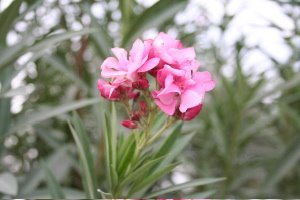Eating a Granny Smith with a faint aroma of insecticide, which is slightly numbing to the tongue; lovely (not). It is very difficult to get good fruit and vegetables here and I have become diligent about washing everything. But when you don’t have any water to speak of, you are certainly up against it as a market gardener. Apparently if you tap into the water table here, sea water floods in.
Checking out a shopping basket, very little comes from here. The water I get in 5 litre bottles for about 80 cents comes from KSA (
The vegetables I get in the local supermarket vary in price and are erratic in quality. Tomatoes, which may well be grown here, come in all shapes and stages of ripeness, but costs only 25 cents a kilo. Onions are equally cheap, as are peppers. Cauliflower (the staple of my diet) cost about a euro a head. Courgettes, which are more like mini-cucumbers, cost just over a euro for a small bag of about ten. Apples costs about Eu1.20 for five.
Locals buy tomatoes, onions and oranges by the ton. They must buy for large extended family judging by the bulging bags they bring to be weighed by the polite chap at the scales, who looks as if he never sees sunlight; his skin is alabaster white.
There is a whole section for Indian vegetables, of which the strangest is a long, hairy looking version of cucumber. Despite my love of Indian food, I recognise only okra. In a fridge, you will find scallions and sprigs of green leaves – some are herbs like mint, which is so central to Middle Eastern cooking, but I don’t recognise them all.
Everything has to go in plastic bags, which drives me nuts. I diligently bring a large bag of plastic wrapping into work one day a week. They have an immense plastic re-cycling plant in the industrial area, yet do nothing to encourage individuals to divide their waste.
Back to the shopping basket and moving away from fruit and veg, we have tahini from KSA, plus all sorts of biscuits and confectionary and the condensed milk locals put in their version of tea – very strong, very milky and very, very sweet.
From
Halloumi cheese (which has to be cooked) is imported from
So what do the locals buy? Apart from the industrial quantities of tomatoes and oranges, it is mainly plastic (of course) bags of white rolls and other Western processed foods ranging from frozen pizzas and burgers to corn flakes; soft drinks and coffee as well of course, plus highly sugared fruit juices. They also indulge in their native ‘sweetmeats’ and biscuits, used for their evening picnics. They have a soured milk called labneh, which I like. It comes as a cheese or in a liquefied form. In the local supermarket, you can buy all sorts of pulses and nuts from sacks, but have never noticed a huge demand. Pig and its by-products, of course, are banned. They have ‘pork rooms’ where Westerners can buy their rashers and sausages in some Muslim counties, but I haven’t noticed any here, where the prevailing sect is W*hhabi, so very strict.
In KSA, they have the highest rate of diabetes in the world (one in three) and the Gulf nations aren’t far behind. They also have as large a quota of fat and obese children as we have back home, plus a high rate of hospitalisation per head of population. Not a healthy people.
































No comments yet.